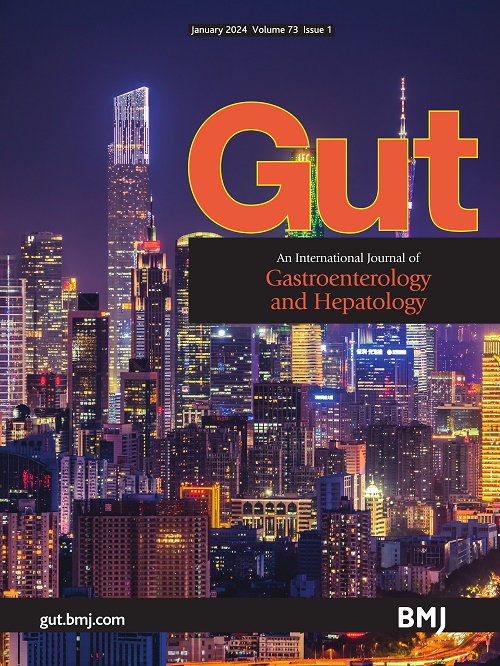恶性胃出口梗阻的内镜或手术胃肠造口术:一项随机试验
IF 25.8
1区 医学
Q1 GASTROENTEROLOGY & HEPATOLOGY
引用次数: 0
摘要
虽然外科胃空肠造口术(SGJ)是缓解胃出口梗阻(GOO)的标准方法,但内镜下方法-内镜超声引导下的胃肠造口术(EUS-GE) -已被提出作为一种新颖的,侵入性较小的方法。目的比较两种方法,以确定EUS-GE的临床效果是否优于手术。我们进行了一项多中心、随机优势试验,对恶性粘稠症患者进行EUS-GE或SGJ治疗。主要终点是复合测量,包括出院时胃出口阻塞评分系统(GOOSS)评分为0或1,再次干预或补充营养的需要,或6个月随访期间或直到死亡的手术相关不良事件。次要终点为固体饮食时间、住院时间、健康相关生活质量(HRQoL)和治疗费用。结果74例患者随机分为EUS-GE组(38例)和SGJ组(36例)。在接受EUS-GE的患者中,主要终点发生率为7.9%,而在接受SGJ的患者中,主要终点发生率为38.9%(风险差异为- 31.0%,95% CI为- 47.6%至- 11.4%,p=0.002)。EUS-GE与更快地推进到固体饮食(中位2天(P25-P75, 2 - 3) vs 5天(P25-P75, 3.5-9)、更短的住院时间(中位3天(P25-P75, 3 - 6) vs 9天(P25-P75, 6-12.5)、更好的HRQoL (p=0.0016)和社会功能(p=0.011)以及更低的治疗费用(33934美元vs 5437美元,差异- 17503美元(95% CI - 27807美元至- 7920美元)相关。结论:在这项随机试验中,EUS-GE在口服摄入量、需要再干预或补充营养、住院时间、生活质量和治疗费用方面优于SGJ。试验注册号[NCT05548114][1]。如有合理要求,可提供资料。本文中的所有文本、表格和图表可供其他研究人员使用。对于个体参与者数据的荟萃分析,将在审查和验证后提供个体水平的去识别患者数据。研究者应联系通讯作者索取资料,并提供相应的研究方案和研究所的证明。这些将由试验组审查委员会核实和批准,并执行数据访问协议。所有数据将开始与出版和出版后12个月结束可用。[1]: /查找/ external-ref ? link_type = CLINTRIALGOV&access_num = NCT05548114&atom = % 2 fgutjnl % 2恐惧% 2 f2025 % 2 f09 % 2 f24 % 2 fgutjnl - 2025 - 336339. -原子本文章由计算机程序翻译,如有差异,请以英文原文为准。
Endoscopic or surgical gastroenterostomy for malignant gastric outlet obstruction: a randomised trial
Background Although surgical gastrojejunostomy (SGJ) is the standard method for palliation of gastric outlet obstruction (GOO), an endoscopic method—endoscopic ultrasound-guided gastroenterostomy (EUS-GE)—has been proposed as a novel, less invasive approach. Objective We compared both methods to determine whether clinical outcomes for EUS-GE are superior to surgery. Design We conducted a multicentre, randomised superiority trial of patients with malignant GOO to receive either EUS-GE or SGJ. Primary endpoint was composite measure, consisting of Gastric Outlet Obstruction Scoring System (GOOSS) score of 0 or 1 at hospital discharge, need for reinterventions or supplemental nutrition, or procedure-related adverse events during 6-month follow-up or until death. Secondary endpoints were time to solid diet, length of hospitalisation, health-related quality of life (HRQoL) and treatment costs. Results 74 patients were randomly assigned to EUS-GE (38 patients) or SGJ (36 patients). Primary endpoint occurred in 7.9% of patients who received EUS-GE and 38.9% in SGJ (risk difference −31.0%, 95% CI −47.6% to −11.4%, p=0.002). EUS-GE was associated with more rapid advancement to solid diet (median 2 days (P25–P75, 2–3) vs 5 days (P25–P75, 3.5–9)), shorter hospitalisation (median 3 days (P25–P75, 3–6) vs 9 days (P25–P75, 6–12.5)), better HRQoL for physical (p=0.0016) and social functioning (p=0.011) and lower treatment costs (US$33 934 vs US$51 437, difference −US$17 503 (95% CI −US$27 807 to −US$7920)). Conclusion In this randomised trial, EUS-GE was superior to SGJ with regards to oral intake, need for reinterventions or supplemental nutrition, length of hospitalisation, quality of life and treatment costs. Trial registration number [NCT05548114][1]. Data are available upon reasonable request. All text, tables and figures in this article are available to other researchers. For meta-analysis of individual participant data, individual level de-identified patient data will be available after review and verification. Researchers should contact the corresponding author to request data, providing the corresponding study protocol and the certificate of the institute. These will be verified and approved by the review committee of the trial group, with execution of a data access agreement. All data will be available beginning with publication and ending 12 months after publication. [1]: /lookup/external-ref?link_type=CLINTRIALGOV&access_num=NCT05548114&atom=%2Fgutjnl%2Fearly%2F2025%2F09%2F24%2Fgutjnl-2025-336339.atom
求助全文
通过发布文献求助,成功后即可免费获取论文全文。
去求助
来源期刊

Gut
医学-胃肠肝病学
CiteScore
45.70
自引率
2.40%
发文量
284
审稿时长
1.5 months
期刊介绍:
Gut is a renowned international journal specializing in gastroenterology and hepatology, known for its high-quality clinical research covering the alimentary tract, liver, biliary tree, and pancreas. It offers authoritative and current coverage across all aspects of gastroenterology and hepatology, featuring articles on emerging disease mechanisms and innovative diagnostic and therapeutic approaches authored by leading experts.
As the flagship journal of BMJ's gastroenterology portfolio, Gut is accompanied by two companion journals: Frontline Gastroenterology, focusing on education and practice-oriented papers, and BMJ Open Gastroenterology for open access original research.
 求助内容:
求助内容: 应助结果提醒方式:
应助结果提醒方式:


